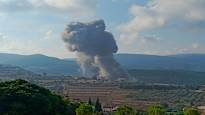According to Professor Teivo Teivainen, Iran is closely monitoring what the United States is doing and whether the Gaza agreement is possible.
The risks of the conflict in the Middle East expanding have increased, the professor of world politics assessed Teivo Teivainen from the University of Helsinki.
Teivainen estimates that Israel’s extensive attacks against the Hezbollah movement in Lebanon foreshadow new attacks.
After Sunday morning’s air strike by hundreds of fighter jets, Israel has continued its attacks on the Lebanese side. Israeli fighter jets struck rockets from Iran-backed Hezbollah. Israel says that with the strikes it prevented large-scale rocket attacks.
According to Teivainen’s assessment, it is at least not a question of flaring up the still-inflamed differences into open flames and wider hostilities.
– It’s about a local escalation of the fighting, but not a big escalation as long as Iran is not directly involved.
The risk of an expansion of the conflict has existed since Iran announced that it would retaliate for a precision strike that killed Ismail Haniyeh, who was characterized as the political leader of Hamas, in July.
A direct revenge attack has not yet been seen, and according to Teivainen, we may not see it yet. Iran’s counterattack can be partly held back by strengthening the presence of the US military in the Persian Gulf.
United States has exceptionally announcedthat it will bring a submarine capable of strategic strikes to the Persian Gulf in addition to aircraft carriers.
– Iran’s direct interference could lead to Israel and the United States destroying targets related to Iran’s nuclear weapons program.
According to Teivainen, Iran’s attacks can also be restrained to some extent by its desire to see if an agreement can be reached between Hamas and Israel on the situation in Gaza. The agreement is to be negotiated in Cairo, and the morning’s attacks have not stopped the plan, at least so far.
